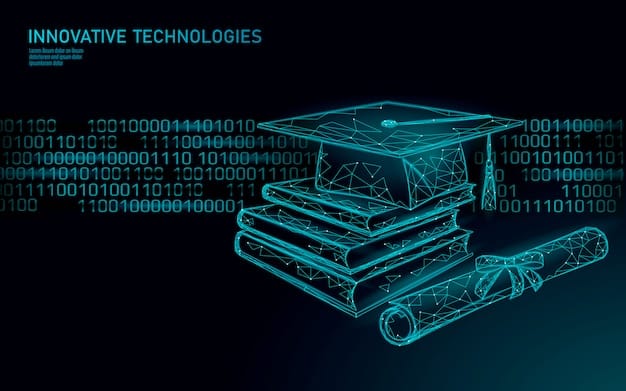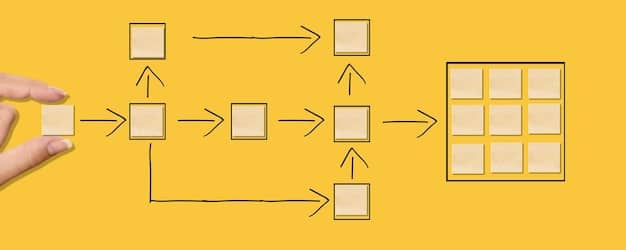Decoding Federal Student Loan Forgiveness Programs: Latest Updates

Decoding the Latest Updates to Federal Student Loan Forgiveness Programs involves understanding recent changes to eligibility criteria, application processes, and the overall landscape of student loan relief initiatives in the United States.
Navigating the landscape of federal student loan forgiveness programs can feel like deciphering a complex code. With frequent updates and evolving guidelines, it’s crucial to stay informed. This article aims to decode the latest changes to federal student loan forgiveness programs, providing clarity and actionable insights for borrowers.
Understanding the Current Federal Student Loan Forgiveness Landscape
The terrain of federal student loan forgiveness is ever-shifting, influenced by policy changes, economic conditions, and legal challenges. Keeping abreast of these developments is paramount for borrowers seeking relief.
Several key programs and initiatives currently shape the landscape. These include Public Service Loan Forgiveness (PSLF), Income-Driven Repayment (IDR) forgiveness, and various targeted forgiveness programs designed to address specific borrower needs. Let’s delve into the core components of the current environment.
Key Federal Student Loan Forgiveness Programs
Several programs are available to borrowers seeking loan forgiveness. Understanding the eligibility requirements, application processes, and benefits of each program is critical for making informed decisions.
- Public Service Loan Forgiveness (PSLF): Forgives the remaining balance on Direct Loans after 120 qualifying monthly payments made under a qualifying repayment plan while working full-time for a qualifying employer.
- Income-Driven Repayment (IDR) Forgiveness: Forgives the remaining balance on loans after 20 or 25 years of payments under an income-driven repayment plan, such as Income-Based Repayment (IBR), Pay As You Earn (PAYE), or Saving on a Valuable Education (SAVE).
- Teacher Loan Forgiveness: Offers forgiveness of up to $17,500 on Direct Loans or FFEL Program loans for qualified teachers who teach full-time for five consecutive years in a low-income school or educational service agency.
Navigating these programs requires careful attention to detail and a thorough understanding of the rules and regulations. Borrowers should research each program thoroughly and seek guidance from trusted sources to determine which options best align with their individual circumstances.
In summary, the current federal student loan forgiveness landscape is complex and requires careful navigation. By understanding the key programs and recent changes, borrowers can make informed decisions and pursue the relief they are entitled to.

Recent Updates to Public Service Loan Forgiveness (PSLF)
The Public Service Loan Forgiveness (PSLF) program has undergone significant changes in recent years, aimed at making it more accessible and effective for public service workers. These updates have addressed issues that previously hindered many borrowers from qualifying for forgiveness.
Understanding and adapting to these changes is essential for public service employees who are pursuing loan forgiveness. Let’s explore some key modifications and initiatives implemented to streamline the PSLF process.
Temporary Changes and the Limited PSLF Waiver
One of the most significant changes to PSLF was the implementation of the Limited PSLF Waiver, which allowed borrowers to receive credit for past payments that previously did not qualify under the program’s strict rules.
- Expanded Qualifying Payments: The waiver allowed payments made under any repayment plan to qualify for PSLF, including those that were not income-driven.
- Consolidation Opportunities: Borrowers with Federal Family Education Loan (FFEL) Program loans were able to consolidate into Direct Loans to become eligible for PSLF.
- Retroactive Credit: The waiver provided retroactive credit for payments made while working for a qualifying employer, even if the borrower was not in a qualifying repayment plan at the time.
The Limited PSLF Waiver provided a valuable opportunity for many public service workers to accelerate their progress toward loan forgiveness. Borrowers who took advantage of the waiver had a greater chance of qualifying for PSLF under the updated rules.
To conclude, the recent updates to PSLF, including the Limited PSLF Waiver, have made the path to loan forgiveness more accessible for public service workers. By understanding these changes and taking appropriate action, borrowers can maximize their chances of qualifying for PSLF and receiving the relief they deserve.
Decoding Income-Driven Repayment (IDR) Plan Adjustments
Income-Driven Repayment (IDR) plans have also seen significant adjustments recently, impacting how borrowers manage and eventually have their student loans forgiven. These adjustments are designed to make repayment more affordable and forgiveness more attainable.
Understanding these IDR plan adjustments is crucial for borrowers to make informed decisions about their repayment strategy. Let’s delve into the details of these changes and their implications for borrowers.
The SAVE Plan: A New Income-Driven Repayment Option
The Saving on a Valuable Education (SAVE) plan is the newest income-driven repayment plan. It offers several benefits that make it a more attractive option compared to older IDR plans.
- Lower Monthly Payments: The SAVE plan calculates monthly payments based on a borrower’s income and family size, and it protects more of a borrower’s income from being used for payments.
- Interest Benefit: Under the SAVE plan, if a borrower’s calculated monthly payment does not cover the full amount of accruing interest, the government will waive the remaining interest. This prevents loan balances from growing due to unpaid interest.
- Faster Forgiveness for Low-Balance Borrowers: Borrowers with smaller original loan balances may qualify for forgiveness after as little as 10 years of payments under the SAVE plan.
The SAVE plan is designed to provide more affordable payments and faster forgiveness for borrowers with low incomes and high student loan debt. It represents a significant improvement over older IDR plans and offers valuable relief to struggling borrowers.
In conclusion, the adjustments to Income-Driven Repayment (IDR) plans, most notably the introduction of the SAVE plan, offer significant benefits for borrowers seeking affordable repayment and eventual loan forgiveness. By understanding these changes and enrolling in the most suitable IDR plan, borrowers can effectively manage their student loan debt and move toward financial stability.

Navigating the One-Time Account Adjustment
The One-Time Account Adjustment is a significant initiative by the U.S. Department of Education to correct historical inaccuracies in the counting of payments made toward income-driven repayment (IDR) plans and Public Service Loan Forgiveness (PSLF).
This adjustment aims to ensure that borrowers receive accurate credit for their past payments, potentially bringing them closer to loan forgiveness. Let’s explore what this adjustment entails and how borrowers can benefit from it.
Who is Eligible for the One-Time Account Adjustment?
The One-Time Account Adjustment is designed to benefit borrowers who have experienced errors in the counting of their qualifying payments for IDR and PSLF. Eligible borrowers typically include those who have:
- Long-term Repayment History: Borrowers who have been in repayment for many years and have made numerous payments under various repayment plans.
- Consolidated Loans: Borrowers who have consolidated their loans, which may have resulted in a reset of their payment counts.
- Errors in Payment Tracking: Borrowers who have encountered errors in the tracking of their qualifying payments by loan servicers.
The One-Time Account Adjustment provides an opportunity for borrowers to have their payment counts reviewed and corrected, potentially accelerating their progress toward loan forgiveness. It addresses past issues and ensures fair treatment for borrowers who have been diligently repaying their loans.
In conclusion, the One-Time Account Adjustment is a crucial initiative to rectify historical inaccuracies in payment counting for IDR and PSLF. By understanding the eligibility criteria and taking appropriate action, borrowers can ensure they receive accurate credit for their past payments and move closer to loan forgiveness.
Strategies for Maximizing Loan Forgiveness Eligibility
Maximizing eligibility for loan forgiveness programs requires careful planning and strategic decision-making. Borrowers should take proactive steps to ensure they meet all the requirements and maximize their chances of receiving forgiveness.
Let’s explore some strategies borrowers can employ to improve their eligibility and optimize their loan forgiveness outcomes.
Consolidating Loans for PSLF Eligibility
Consolidating Federal Family Education Loan (FFEL) Program loans into Direct Loans can be a crucial step toward qualifying for Public Service Loan Forgiveness (PSLF).
- Direct Loan Requirement: PSLF is only available for Direct Loans. Borrowers with FFEL loans must consolidate into a Direct Consolidation Loan to become eligible.
- Waiver Benefits: Consolidating loans under the Limited PSLF Waiver allowed borrowers to receive credit for past payments made on FFEL loans.
- Simplified Repayment: Consolidation can simplify repayment by combining multiple loans into a single loan with a single payment.
Consolidating loans can be a strategic move for borrowers seeking PSLF, providing access to the program and potentially accelerating their progress toward forgiveness. Borrowers should carefully consider the implications of consolidation before making a decision.
In summary, maximizing loan forgiveness eligibility involves proactive planning and strategic decision-making. By consolidating loans, exploring IDR plans, documenting employment, and seeking expert advice, borrowers can enhance their chances of receiving loan forgiveness and achieving financial freedom.
Seeking Expert Advice and Resources
Navigating the complexities of federal student loan forgiveness programs can be challenging. Seeking expert advice and utilizing available resources can provide borrowers with valuable guidance and support.
Let’s explore some resources and avenues for seeking expert advice to help borrowers effectively manage their student loans and pursue forgiveness.
Utilizing the Federal Student Aid Website
The Federal Student Aid website provides a wealth of information and resources for borrowers seeking to understand and manage their student loans.
- Program Information: The website offers detailed information about various loan forgiveness programs, including PSLF, IDR, and Teacher Loan Forgiveness.
- Eligibility Requirements: Borrowers can find detailed eligibility requirements and application instructions for each program.
- Repayment Options: The website provides tools and resources for exploring different repayment options, including income-driven repayment plans.
By utilizing the Federal Student Aid website, borrowers can access accurate and up-to-date information about federal student loan forgiveness programs and make informed decisions about their repayment strategy.
In conclusion, seeking expert advice and utilizing available resources can empower borrowers to navigate the complexities of federal student loan forgiveness programs successfully. By consulting with financial advisors, contacting loan servicers, and leveraging online resources, borrowers can gain the knowledge and support they need to manage their student loans effectively and pursue forgiveness.
| Key Point | Brief Description |
|---|---|
| 🔑 PSLF Updates | Temporary changes and the Limited PSLF Waiver offer expanded qualifying payments. |
| 💰 SAVE Plan | A new IDR option with lower payments and interest benefits. |
| ⏱️ One-Time Adjustment | Corrects historical inaccuracies in IDR and PSLF payment counts. |
| 💡 Loan Consolidation | Consolidate FFEL loans into Direct Loans to become PSLF eligible. |
Frequently Asked Questions (FAQ)
▼
The PSLF program forgives the remaining balance on Direct Loans after 120 qualifying monthly payments made under a qualifying repayment plan while working full-time for a qualifying employer.
▼
The SAVE plan is a new income-driven repayment plan that offers lower monthly payments and interest benefits. It calculates payments based on income and family size.
▼
Eligible borrowers include those with long-term repayment history, consolidated loans, or errors in payment tracking for IDR and PSLF.
▼
Consolidating FFEL loans into Direct Loans makes you eligible for PSLF. It can also simplify repayment by combining multiple loans into one.
▼
You can find detailed information on the Federal Student Aid website and consult with financial advisors or your loan servicer for personalized guidance.
Conclusion
Staying informed about the latest updates to federal student loan forgiveness programs is crucial for borrowers seeking financial relief. By understanding the nuances of programs like PSLF, the SAVE plan, and the One-Time Account Adjustment, borrowers can strategically manage their student loans and maximize their chances of achieving forgiveness. Remember to seek expert advice and utilize available resources to navigate this complex landscape effectively.





